Biorefining of Pigeon Pea: Residue Conversion by Pyrolysis
Abstract
Highlights
- Pigeon pea wood was pyrolyzed aiming at high bio-oil yields;
- Optimized yields were 54 wt.% on dry feed intake;
- The bio-oils have a higher H/C ratio and a similar O/C ratio than reported for other woods, due to the presence of low amounts of lignin in the pigeon pea wood feed;
- The bio-oil contains a vast range of functional groups of aliphatic, aromatic, aldehydes, ketones, carboxylic acids, phenolics and also oligomeric products, based GC–MS and GPC analysis, as well as the NMR measurements (13C- and HSQC-NMR);
- This present work contributes to the development of efficient biorefining concepts for pigeon peas.
1. Introduction
2. Experimental Section
2.1. Biomass Preparation and Characterization
2.2. Pyrolysis Experiments and Experimental Design
2.3. Bio-Oil Characterization
3. Results and Discussion
3.1. Description of a Typical Experiment
3.2. Optimization Studies
3.3. Validation of Optimized Model Conditions and Comparison of Bio-Oil Yields Obtained in a Fluidized Bed Reactor
3.4. Properties and Molecular Composition of the Bio-Oils
4. Conclusions
Supplementary Materials
Author Contributions
Funding
Acknowledgments
Conflicts of Interest
References
- Venderbosch, R.H.; Prins, W. Fast pyrolysis technology development. Biofuels Bioprod. Biorefin. 2010, 4, 178–208. [Google Scholar] [CrossRef]
- De Wild, P.; Reith, H.; Heeres, H.J. Biomass pyrolysis for chemicals. Biofuels 2011, 2, 185–208. [Google Scholar] [CrossRef]
- Manurung, R.; Wever, D.A.Z.; Wildschut, J.; Venderbosch, R.H.; Hidayat, H.; van Dam, J.E.G.; Leijenhorst, E.J.; Broekhuis, A.A. Valorisation of Jatropha curcas L. plant parts: Nutshell conversion to fast pyrolysis oil. Food Bioprod. Process 2009, 87, 187–196. [Google Scholar] [CrossRef]
- Venderbosch, R.H.; Prins, W.; Wagenaar, B.M. Flash pyrolysis of wood for energy and chemicals: Part 1. NPT Procestechnol. 1999, 6, 18–23. [Google Scholar]
- Dhyani, V.; Bhaskar, T. A comprehensive review on the pyrolysis of lignocellulosic biomass. Renew. Energy 2018, 129, 695–716. [Google Scholar] [CrossRef]
- Czernik, S.; Bridgwater, A.V. Overview of applications of biomass fast pyrolysis oil. Energy Fuels 2004, 18, 590–598. [Google Scholar] [CrossRef]
- Jung, S.H.; Kang, B.S.; Kim, J.S. Production of bio-oil from rice straw and bamboo sawdust under various reaction conditions in a fast pyrolysis plant equipped with a fluidized bed and a char separation system. J. Anal. Appl. Pyrolysis 2008, 82, 240–247. [Google Scholar] [CrossRef]
- Venderbosch, R.H. A critical view on catalytic pyrolysis of biomass. ChemSusChem 2015, 8, 1306–1316. [Google Scholar] [CrossRef]
- Jaworski, T.; Kajda-Szczesniak, M. Research on the kinetics of pyrolysis of wood-based panels in terms of waste management. Energies 2019, 12, 3705. [Google Scholar] [CrossRef]
- Dayton, D.C.; Carpenter, J.R.; Kataria, A.; Peters, J.E.; Barbee, D.; Mante, O.D.; Gupta, R. Design and operation of a pilot-scale catalytic biomass pyrolysis unit. Green Chem. 2015, 17, 4680–4689. [Google Scholar] [CrossRef]
- Yildiz, G.; Ronsse, F.; van Duren, R.; Prins, W. Challenges in the design and operation of processes for catalytic fast pyrolysis of woody biomass. Renew. Sustain. Energy Rev. 2016, 57, 1596–1610. [Google Scholar] [CrossRef]
- Ardiyanti, A.R.; Gutierrez, A.; Honkela, M.L.; Krause, A.O.I.; Heeres, H.J. Hydrotreatment of wood-based pyrolysis oil using zirconia-supported mono- and bimetallic (Pt, Pd, Rh) catalysts. Appl. Catal. A 2011, 407, 56–66. [Google Scholar] [CrossRef]
- Yin, W.; Kloekhorst, A.; Venderbosch, R.H.; Bykova, M.V.; Khromova, S.A.; Yakovlev, V.A.; Heeres, H.J. Catalytic hydrotreatment of fast pyrolysis liquids in batch and continuous set-ups using a bimetallic Ni-Cu catalyst with a high metal content. Cat. Sci. Technol. 2016, 6, 5899–5915. [Google Scholar] [CrossRef]
- Wildschut, J.; Mahfud, F.H.; Venderbosch, R.H.; Heeres, H.J. Hydrotreatment of fast pyrolysis oil using heterogeneous noble-metal catalysts. Ind. Eng. Chem. Res. 2009, 48, 10324–10334. [Google Scholar] [CrossRef]
- Yin, W.; Venderbosch, R.H.; Alekseeva, M.V.; Figueirêdo, M.B.; Heeres, H.; Khomova, S.A.; Yakovlev, V.A.; Cannilla, C.; Bonura, G.; Frusteri, F.; et al. Hydrotreatment of the carbohydrate-rich fraction of pyrolysis liquids using bimetallic Ni based catalyst: Catalyst activity and product property relations. Fuel Process. Technol. 2018, 169, 258–268. [Google Scholar] [CrossRef]
- Figueirêdo, M.B.; Deuss, P.J.; Venderbosch, R.H.; Heeres, H.J. Valorization of pyrolysis liquids: Ozonation of the pyrolytic lignin fraction and model components. ACS Sustain. Chem. Eng. 2019, 7, 4755–4765. [Google Scholar] [CrossRef]
- Yin, W.; Alekseeva, M.V.; Venderbosch, R.H.; Yakovlev, V.A.; Heeres, H.J. Catalytic hydrotreatment of the pyrolytic sugar and pyrolytic lignin fractions of fast pyrolysis liquids using nickel-based catalysts. Energies 2020, 13, 285. [Google Scholar] [CrossRef]
- Figueirêdo, M.B.; Deuss, P.J.; Venderbosch, R.H.; Heeres, H.J. Catalytic hydrotreatment of pyrolytic lignins from different sources to biobased chemicals: Identification of feed-product relations. Biomass Bioenergy 2020, 134, 105484. [Google Scholar] [CrossRef]
- De Wild, P.J.; Huijgen, W.J.J.; Kloekhorst, A.; Chowdari, R.K.; Heeres, H.J. Biobased alkylphenols from lignins via a two-step pyrolysis—Hydrodeoxygenation approach. Bioresour. Technol. 2017, 229, 160–168. [Google Scholar] [CrossRef]
- Agarwal, S.; Chowdari, R.K.; Hita, I.; Heeres, H.J. Experimental studies on the hydrotreatment of Kraft lignin to aromatics and alkylphenolics using economically viable Fe-based catalysts. ACS Sustain. Chem. Eng. 2017, 5, 2668–2678. [Google Scholar] [CrossRef]
- Kumar, C.R.; Anand, N.; Kloekhorst, A.; Cannilla, C.; Bonura, G.; Frusteri, F.; Heeres, H.J. Solvent free depolymerization of Kraft lignin to alkyl-phenolics using supported NiMo and CoMo catalysts. Green Chem. 2015, 17, 4921–4930. [Google Scholar] [CrossRef]
- Kim, S.J.; Jung, S.H.; Kim, J.S. Fast pyrolysis of palm kernel shells: Influence of operation parameters on the bio-oil yield and the yield of phenol and phenolic compounds. Bioresour. Technol. 2010, 101, 9294–9300. [Google Scholar] [CrossRef] [PubMed]
- Saxena, K.B. Seed Production System in Pigeonpea; International Crops Research Institute for Semi-Arid Tropics: Patancheru, India, 2006; p. 76. [Google Scholar]
- Saxena, K.B.; Mula, M.G.; Sugui, F.P.; Layaoen, H.L.; Domoguen, R.L.; Pascua, M.E.; Mula, R.P.; Daw, W.D.; Gowda, C.L.L.; Kumar, R.V.; et al. Pigeon Pea—A Resilient Crop for the Philippine Drylands; Information Bulletin No. 85; International Crops Research Institute for Semi-Arid Tropics: Patancheru, India, 2010; p. 80. [Google Scholar]
- Mythili, R.; Venkatachalam, P. Briquetting of agro-residues. J. Sci. Ind. Res. India 2013, 72, 58–61. [Google Scholar]
- Singal, V. Indian Agriculture; Indian Economic Data Research Centre: New Delhi, India, 1996; pp. 147–148. [Google Scholar]
- Lirag, M.T.B. Farmers’ knowledge and awareness on pigeonpea (Cajanus cajan) in Camarines Sur, Philippines. J. Agric. Ecol. Res. Int. 2016, 9, 1–10. [Google Scholar] [CrossRef]
- Mula, M.G.; Saxena, K.B. Lifting the Level of Awareness on Pigeon Pea—A Global Perspective; International Crops Research Institute for Semi-Arid Tropics: Patancheru, India, 2010; p. 540. [Google Scholar]
- ICRISAT. Improved ICRISAT Pigeon Pea Varieties and Hybrids for Odisha; International Crops Research Institute for the Semi-Arid Tropics: Patancheru, India, 2013; p. 40. [Google Scholar]
- Katyal, S.K.; Iyer, P.V.R. Thermochemical characterization of pigeon pea stalk for its efficient utilization as an energy source. Energy Sources 2000, 22, 363–375. [Google Scholar]
- Rajkumar, D.; Venkatachalam, P. Physical properties of agro residual briquettes produced from cotton, soybean and pigeon pea stalks. Int. J. Power Eng. Energy 2013, 4, 414–417. [Google Scholar]
- Khardiwar, M.S.; Dubey, A.K.; Mahalle, D.M.; Kumar, S. Study on physical and chemical properties of crop residues briquettes for gasification. Int. J. Renew. Energy Technol. Res. 2013, 2, 237–248. [Google Scholar]
- Gangil, S. Beneficial transitions in thermogravimetric signals and activation energy levels due to briquetting of raw pigeon pea stalk. Fuel 2014, 128, 7–13. [Google Scholar] [CrossRef]
- Tinwala, F.; Mohanty, P.; Parmar, S.; Patel, A.; Pant, K.K. Intermediate pyrolysis of agro-industrial biomasses in bench-scale pyrolyser: Product yields and its characterization. Bioresour. Technol. 2015, 188, 258–264. [Google Scholar] [CrossRef]
- Tanquilut, M.R.C.; Elauria, J.C.; Amongo, R.M.C.; Suministrado, D.C.; Yaptenco, K.F.; Elauria, M.M. Biomass characterization of pigeon pea wood for thermochemical conversion. Philipp. J. Agric. Biosyst. Eng. 2019, 15, 39–52. [Google Scholar]
- Mohan, D.; Pittman, C.U., Jr.; Steele, P.H. Pyrolysis of wood/biomass for bio-oil: A critical review. Energy Fuels 2006, 20, 848–889. [Google Scholar] [CrossRef]
- Genuino, H.C.; Muizebelt, I.; Heeres, A.; Schenk, N.J.; Winkelman, J.G.M.; Heeres, H.J. An improved catalytic pyrolysis concept for renewable aromatics from biomass involving a recycling strategy for co-produced polycyclic aromatic hydrocarbons. Green Chem. 2019, 21, 3802–3806. [Google Scholar] [CrossRef]
- Oasmaa, A.; Elliott, D.C.; Korhonen, J. Acidity of biomass fast pyrolysis oils. Energy Fuels 2010, 24, 6548–6554. [Google Scholar] [CrossRef]
- Capareda, S.C. Introduction to Biomass Energy Conversions; CRC Press, Taylor and Francis Group: Boca Raton, FL, USA, 2014; p. 585. [Google Scholar]
- Abnisa, F.; Wan Daud, W.M.A.; Sahu, J.N. Optimization and characterization studies on bio-oil production from palm shell by pyrolysis using response surface methodology. Biomass Bioenergy 2011, 35, 3604–3616. [Google Scholar] [CrossRef]
- Onay, Ö.; Beis, S.H.; Koçkar, Ö.M. Fast pyrolysis of rape seed in a well-swept fixed bed reactor. J. Anal. Appl. Pyrolysis 2001, 58–59, 995–1007. [Google Scholar] [CrossRef]
- Akhtar, J.; Amin, N.S. A review on operating parameters for optimum liquid oil yield in biomass pyrolysis. Renew. Sustain. Energy Rev. 2012, 16, 5101–5109. [Google Scholar] [CrossRef]
- Guedes, R.E.; Luna, A.S.; Torres, A.R. Operating parameters for bio-oil production in biomass pyrolysis: A review. J. Anal. Appl. Pyrolysis 2018, 129, 134–149. [Google Scholar] [CrossRef]
- Mohammed, I.Y.; Abakr, Y.A.; Kazi, F.K.; Yusuf, S.; Alshareef, I.; Chin, S.A. Pyrolysis of Napier grass in a fixed bed reactor: Effect of operating conditions on product yields and characteristics. BioResources 2015, 10, 6457–6478. [Google Scholar] [CrossRef]
- Pütün, E.; Ateş, F.; Pütün, A.E. Catalytic pyrolysis of biomass in inert and steam atmospheres. Fuel 2008, 87, 815–824. [Google Scholar] [CrossRef]
- Venderbosch, R.H.; Ardiyanti, A.R.; Wildschut, J.; Oasmaa, A.; Heeres, H.J. Stabilization of biomass-derived pyrolysis oils. J. Chem. Technol. Biotechnol. 2010, 85, 674–686. [Google Scholar] [CrossRef]
- Isahak, W.N.R.M.; Hisham, M.W.M.; Yarmo, M.A.; Yun Hin, T.Y. A review on bio-oil production from biomass by using pyrolysis method. Renew. Sustain. Energy Rev. 2012, 16, 5910–5923. [Google Scholar] [CrossRef]
- Oasmaa, A.; Kuoppala, E.; Solantausta, Y. Fast pyrolysis of forestry residue. 2. Physicochemical composition of product liquid. Energy Fuels 2003, 17, 433–443. [Google Scholar] [CrossRef]
- Park, L.K.; Liu, J.; Yiacoumi, S.; Borole, A.P.; Tsouris, C. Contribution of acidic components to the total acid number (TAN) of bio-oil. Fuel 2017, 200, 171–181. [Google Scholar] [CrossRef]
- Nevase, S.S.; Gangde, C.N.; Gangil, S.; Dubey, A.K. Studies on characterisation of biomass fuel. Int. J. Agric. Eng. 2013, 6, 547–551. [Google Scholar]
- Zhang, Q.; Chang, J.; Wang, T.; Xu, Y. Review of biomass pyrolysis oil properties and upgrading research. Energy Convers. Manag. 2007, 48, 87–92. [Google Scholar] [CrossRef]
- Omar, R.; Idris, A.; Yunus, R.; Khalid, K.; Aida Isma, M.I. Characterization of empty fruit bunch for microwave-assisted pyrolysis. Fuel 2011, 90, 1536–1544. [Google Scholar] [CrossRef]
- Channiwala, S.; Parikh, P. A unified correlation for estimating HHV of solid, liquid, and gaseous fuels. Fuel 2002, 81, 1051–1063. [Google Scholar] [CrossRef]
- Prins, M.; Ptasinski, K.; Janssen, F. From coal to biomass gasification: Comparison of thermodynamic efficiency. Energy 2007, 32, 1248–1259. [Google Scholar] [CrossRef]
- Kleinert, M.; Barth, T. Towards a lignocellulosic biorefinery: Direct one-step conversion of lignin to hydrogen-enriched biofuel. Energy Fuels 2008, 22, 1371–1379. [Google Scholar] [CrossRef]
- Branca, C.; Giudicianni, P.; Di Blasi, C. GC/MS characterization of liquids generated from low-temperature pyrolysis of wood. Ind. Eng. Chem. Res. 2003, 42, 3190–3202. [Google Scholar] [CrossRef]
- Bridgwater, A.V. Renewable fuels and chemicals by thermal processing of biomass. Chem. Eng. J. 2003, 91, 87–102. [Google Scholar] [CrossRef]
- Pittman, C.U.; Mohan, D.; Eseyin, A.; Ingram, L.; Hassan, E.-B.M.; Mitchell, B.; Guo, H.; Steele, P.H. Characterization of bio-oils produced from fast pyrolysis of corn stalks in an auger reactor. Energy Fuels 2012, 26, 3816–3825. [Google Scholar] [CrossRef]
- Alén, R.; Kuoppala, E.; Oesch, P. Formation of the main degradation compound groups from wood and its components during pyrolysis. J. Anal. Appl. Pyrolysis 1996, 36, 137–148. [Google Scholar] [CrossRef]
- Hassan, E.-B.M.; Steele, P.H.; Ingram, L. Characterization of fast pyrolysis bio-oils produced from pretreated pine wood. Appl. Biochem. Biotechnol. 2009, 154, 182–192. [Google Scholar] [CrossRef]
- Ingram, L.; Mohan, D.; Bricka, M.; Steele, P.; Strobel, D.; Crocker, D.; Mitchell, B.; Mohammad, J.; Cantrell, K.; Pittman, C.U. Pyrolysis of wood and bark in an auger reactor: Physical properties and chemical analysis of the produced bio-oils. Energy Fuels 2008, 22, 614–625. [Google Scholar] [CrossRef]
- Ben, H.; Ragauskas, A.J. NMR characterization of pyrolysis oils from Kraft lignin. Energy Fuels 2011, 25, 2322–2332. [Google Scholar] [CrossRef]
- Ben, H.; Ragauskas, A.J. Heteronuclear single-quantum correlation-nuclear magnetic resonance (HSQC-NMR) fingerprint analysis of pyrolysis oils. Energy Fuels 2011, 25, 5791–5801. [Google Scholar] [CrossRef]
- Ben, H.; Wu, F.; Wu, Z.; Han, G.; Jiang, W.; Ragauskas, A.J. A comprehensive characterization of pyrolysis oil from softwood barks. Polymers 2019, 11, 1387. [Google Scholar] [CrossRef]
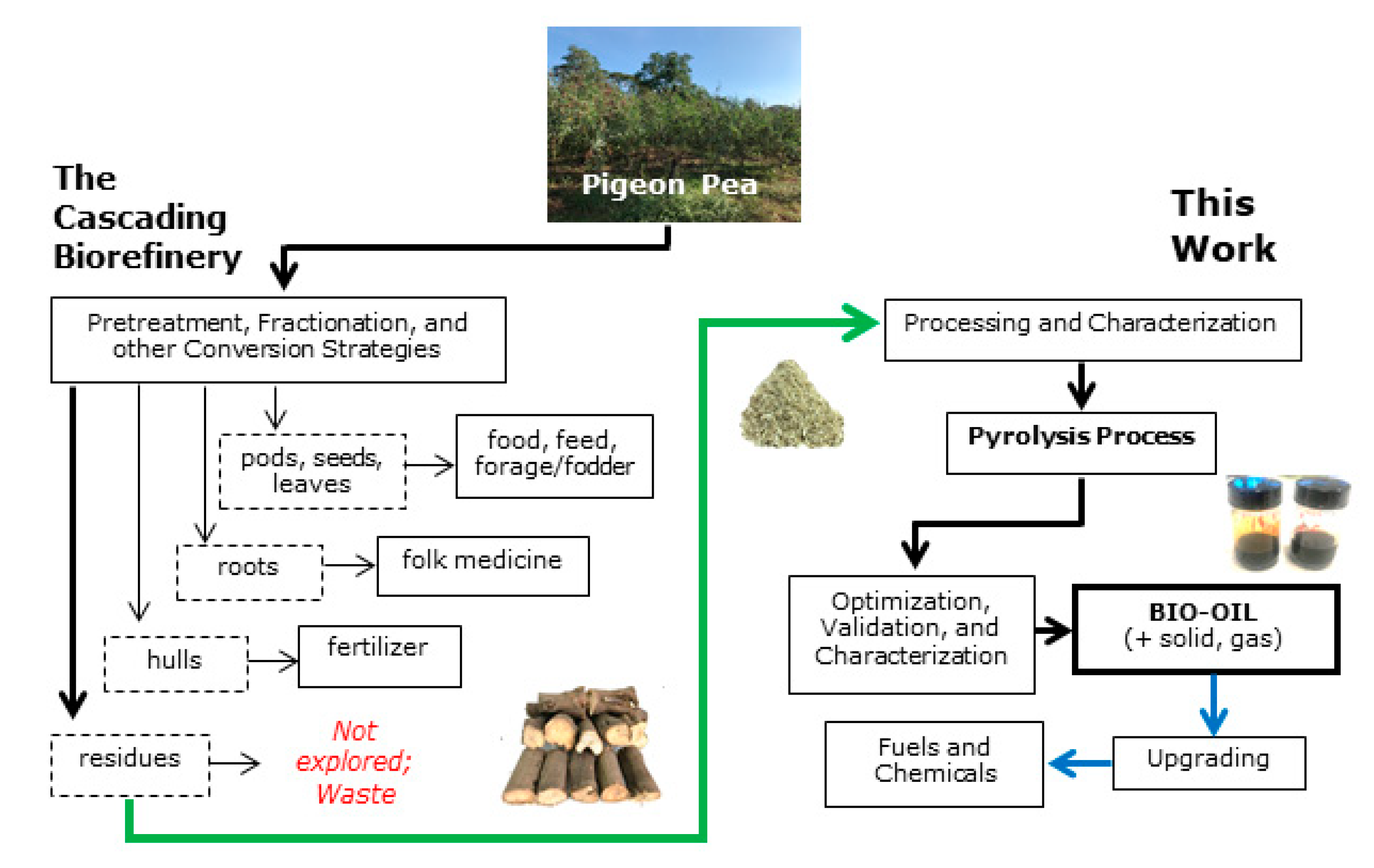
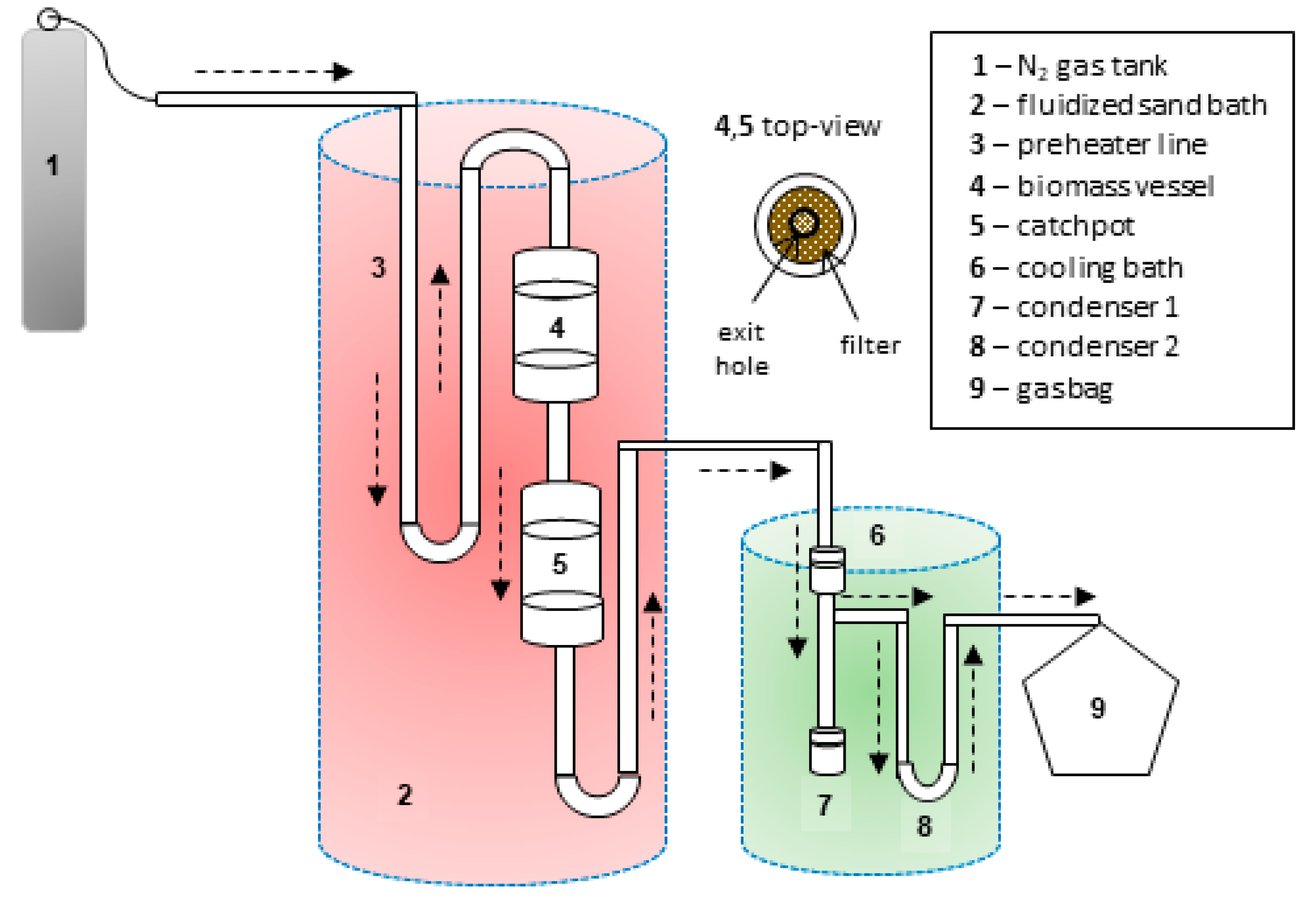
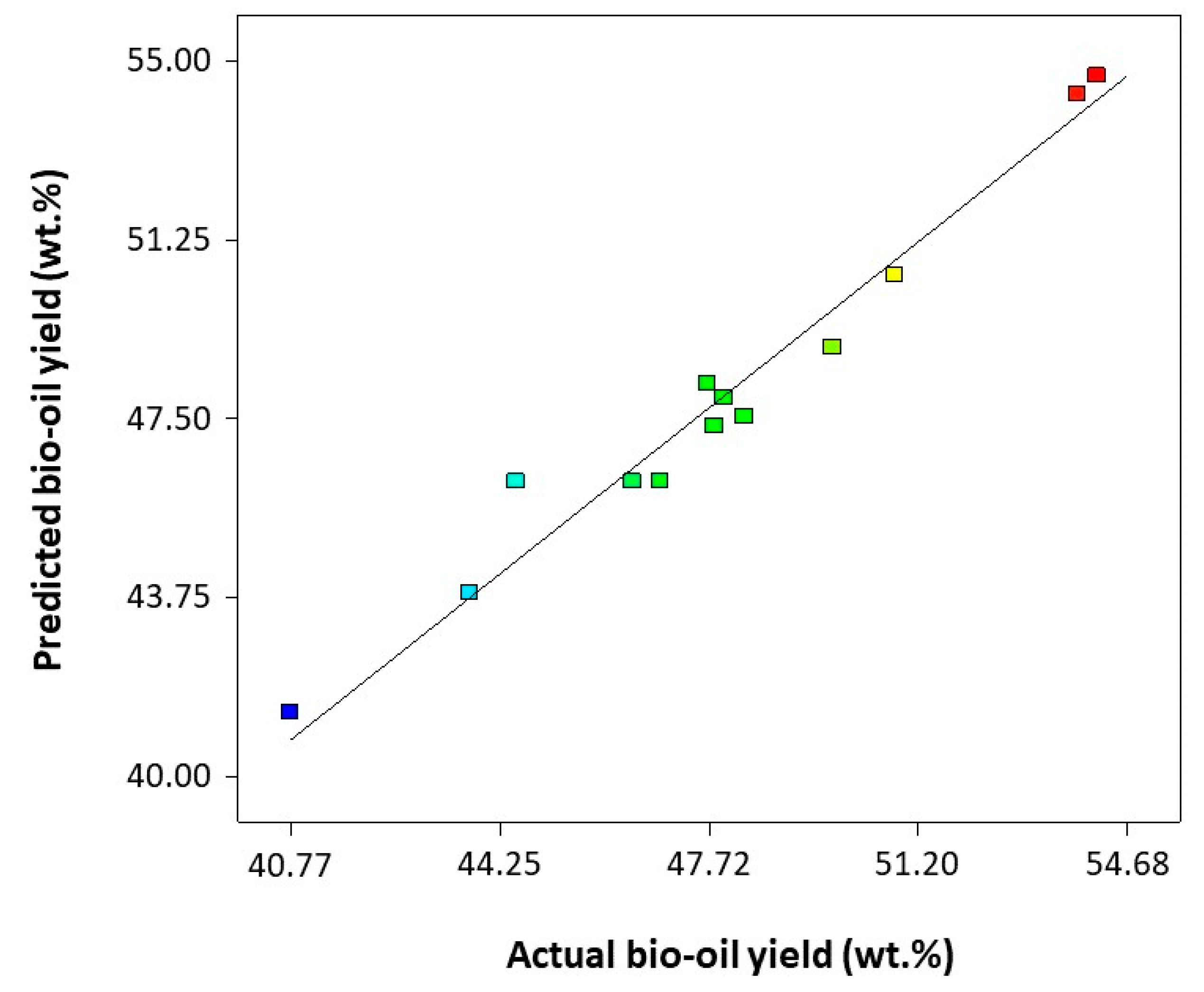
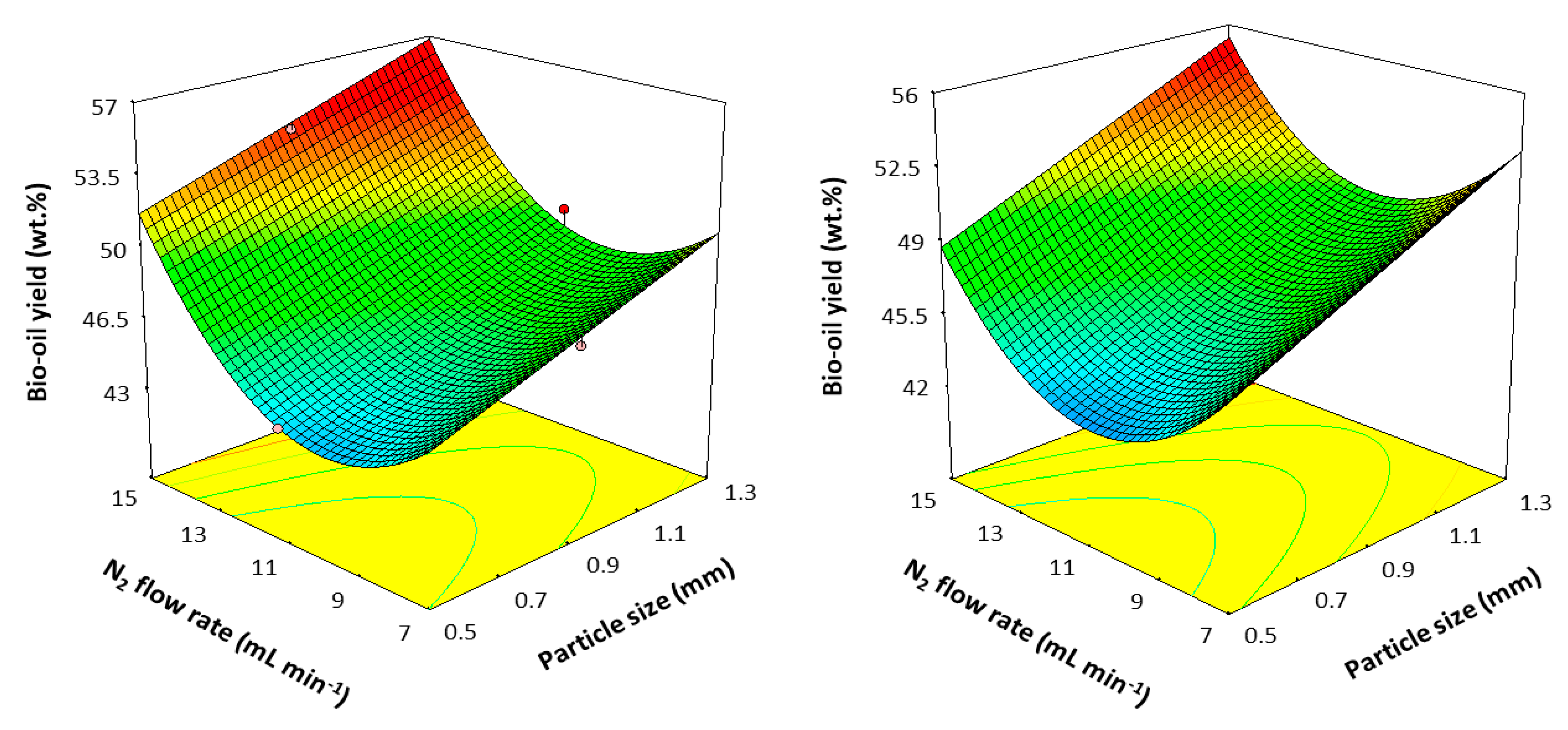
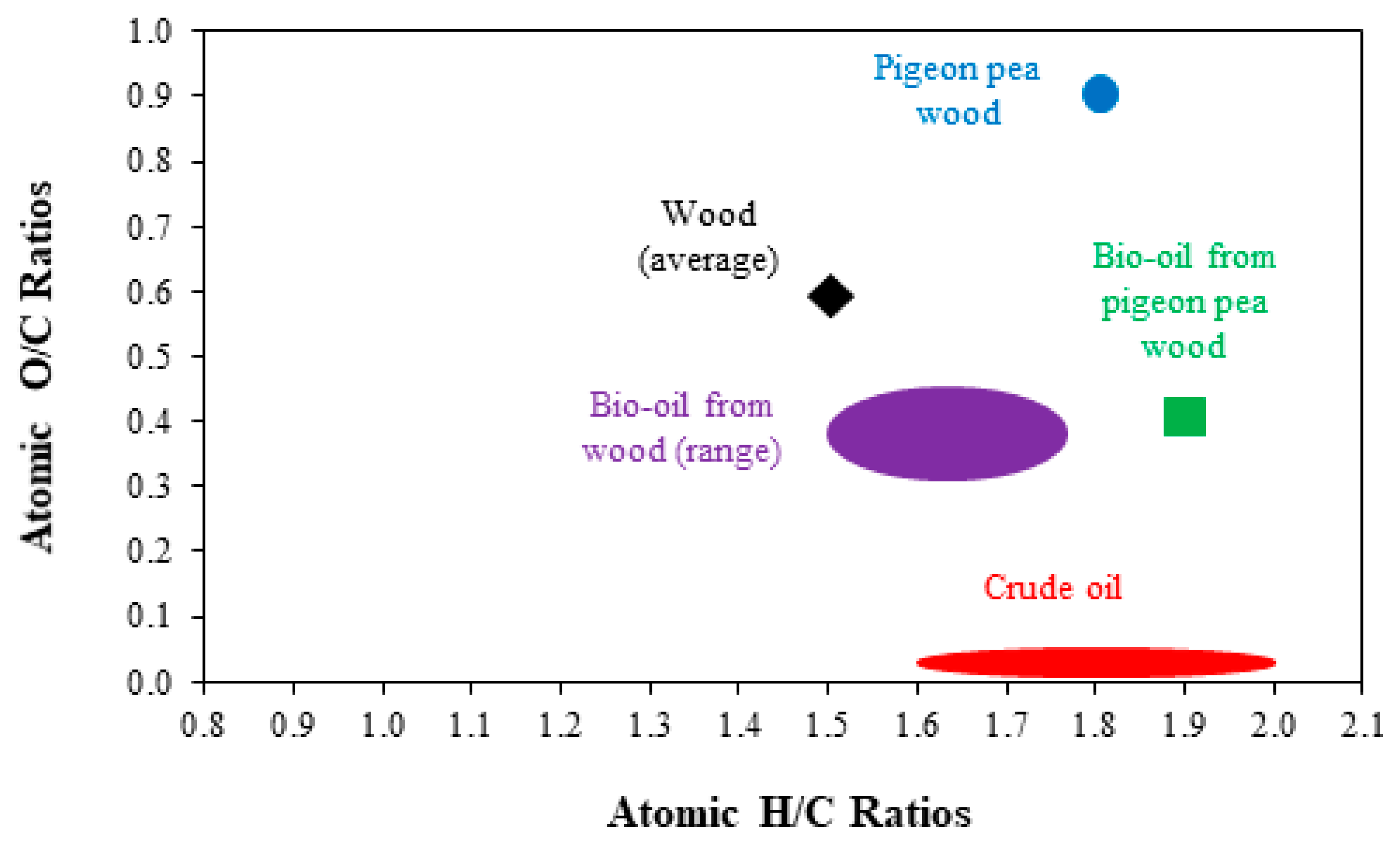
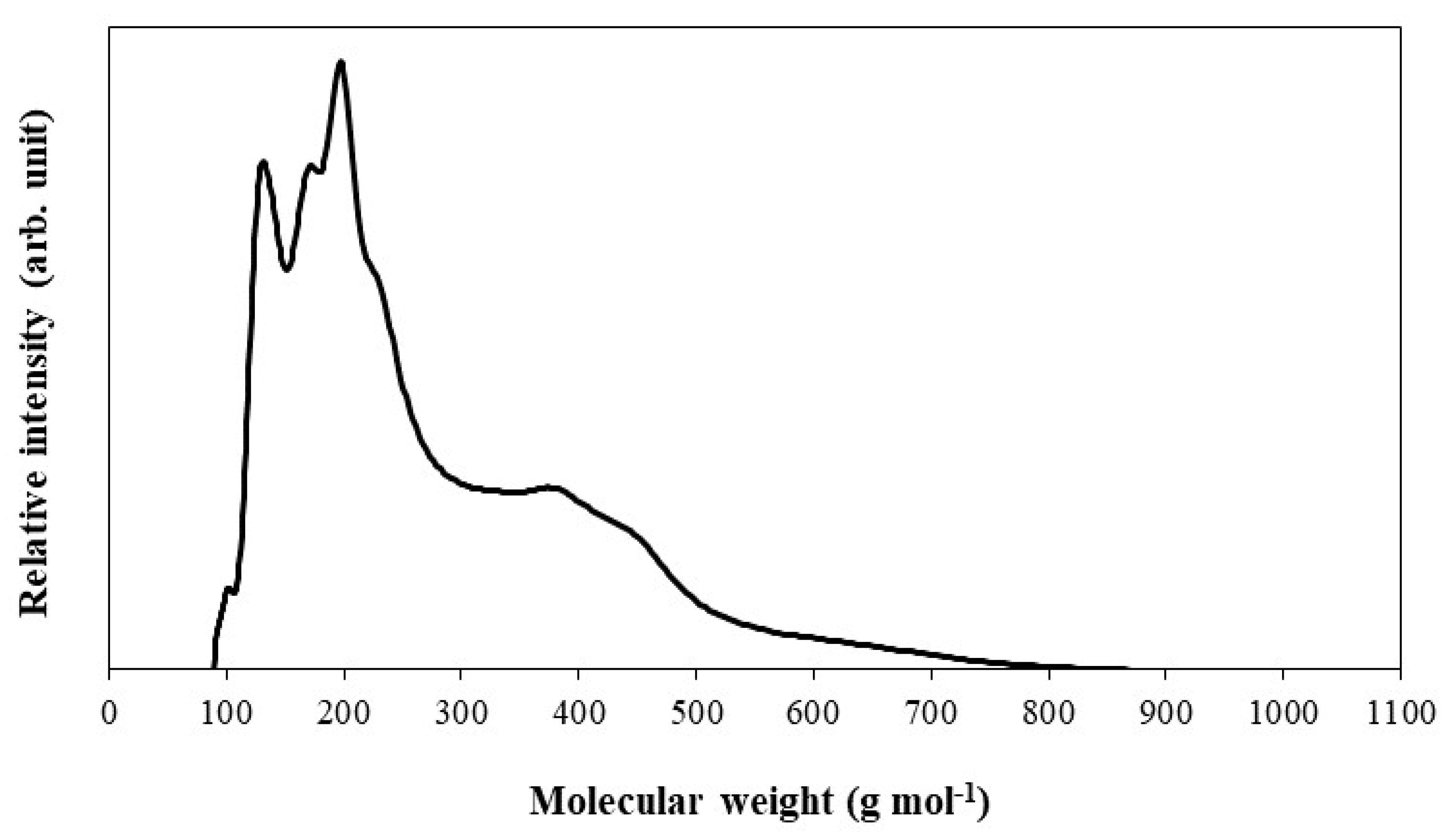
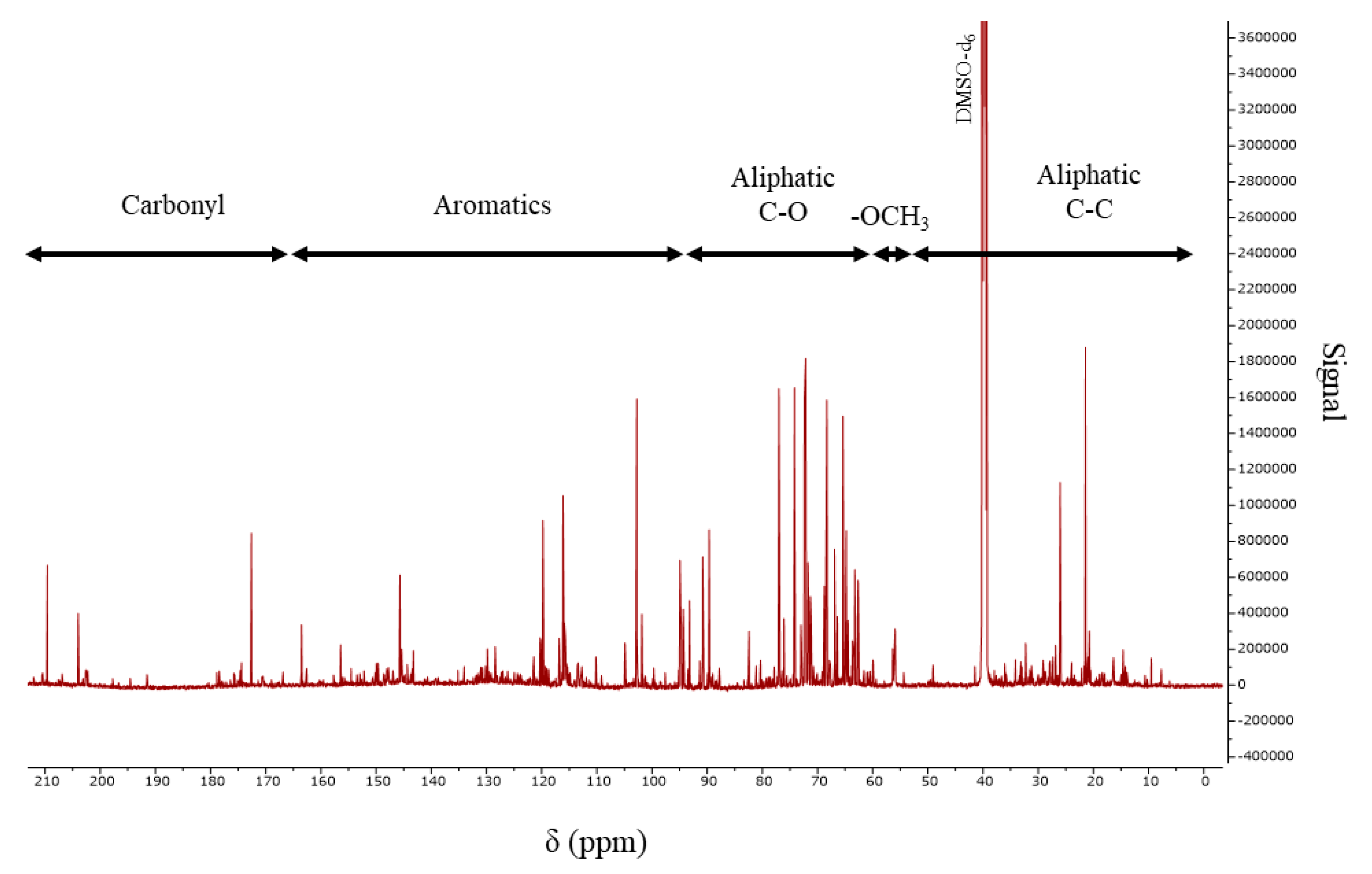
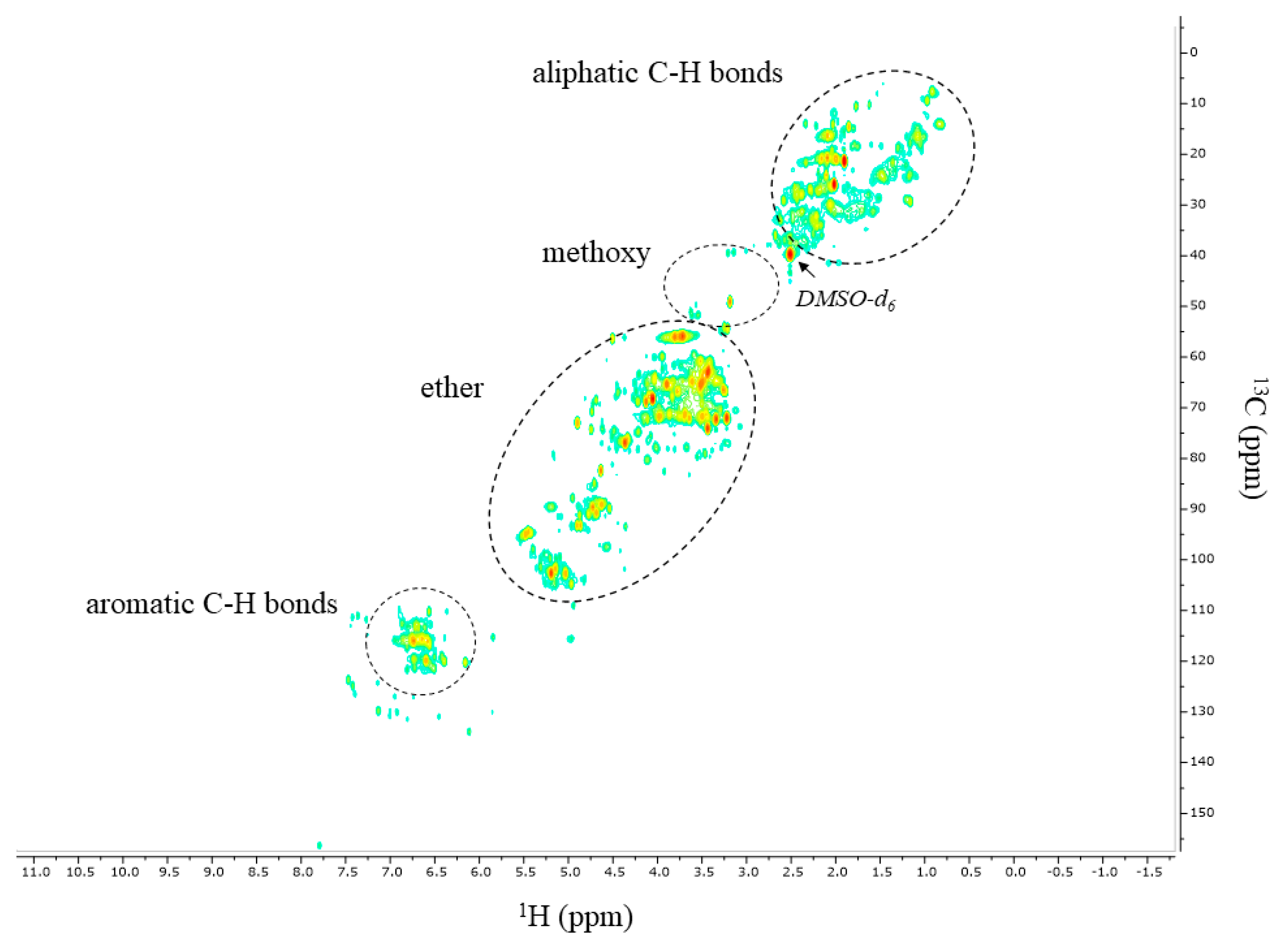
| Property | Value |
|---|---|
| Proximate Analysis | |
| Moisture (%) | 9.9 |
| Volatile matter (%) | 65.9 |
| Ash (%) | 12.3 |
| Fixed carbon (%) | 21.8 |
| Heating Value (MJ kg−1) | 17.1 |
| Ultimate Analysis | |
| Carbon (%) | 41.1 |
| Hydrogen (%) | 6.2 |
| Nitrogen (%) | 0.9 |
| Oxygen (%) | 51.9 |
| Lignocellulosic Analysis | |
| Cellulose (%) | 34.0–34.6 |
| Hemicellulose (%) | 34.2–35.5 |
| Lignin (%) | 17.8–18.2 |
| Run | Coded Factors | Independent Variables | Response, Y | ||||
|---|---|---|---|---|---|---|---|
| X1 | X2 | X3 | Temperature (°C) | Particle Size (mm) | N2 Flow Rate (mL min−1) | Bio-Oil Yield (wt.%) | |
| 1 | +1 | +1 | 0 | 600 | 1.3 | 11 | 51 |
| 2 | +1 | −1 | 0 | 600 | 0.5 | 11 | 41 |
| 3 | −1 | +1 | 0 | 400 | 1.3 | 11 | 50 |
| 4 | −1 | −1 | 0 | 400 | 0.5 | 11 | 44 |
| 5 | +1 | 0 | +1 | 600 | 0.9 | 15 | 48 |
| 6 | +1 | 0 | −1 | 600 | 0.9 | 7 | 36 |
| 7 | −1 | 0 | +1 | 400 | 0.9 | 15 | 54 |
| 8 | −1 | 0 | −1 | 400 | 0.9 | 7 | 48 |
| 9 | 0 | +1 | +1 | 500 | 1.3 | 15 | 54 |
| 10 | 0 | +1 | −1 | 500 | 1.3 | 7 | 47 |
| 11 | 0 | −1 | +1 | 500 | 0.5 | 15 | 48 |
| 12 | 0 | −1 | −1 | 500 | 0.5 | 7 | 48 |
| 13 | 0 | 0 | 0 | 500 | 0.9 | 11 | 47 |
| 14 | 0 | 0 | 0 | 500 | 0.9 | 11 | 46 |
| 15 | 0 | 0 | 0 | 500 | 0.9 | 11 | 45 |
| Source | Seq. SSa | DFb | MSc | Fd | Pe |
|---|---|---|---|---|---|
| Model | 164.06 | 6 | 27.34 | 27.28 | 0.0004 |
| A (Temperature) | 0.32 | 1 | 0.32 | 0.32 | 0.5920 |
| B (Biomass particle size) | 80.51 | 1 | 80.51 | 80.31 | 0.0001 |
| C (N2 flow rate) | 0.033 | 1 | 0.033 | 0.033 | 0.8622 |
| AB | 4.04 | 1 | 4.04 | 4.03 | 0.0915 |
| AC | 18.19 | 1 | 18.19 | 18.15 | 0.0053 |
| C2 | 58.17 | 1 | 58.17 | 58.03 | 0.0003 |
| Residual | 6.01 | 6 | 1 | ||
| Lack of Fit | 2.77 | 4 | 0.69 | 0.43 | 0.788 |
| Pure Error | 3.25 | 2 | 1.62 | ||
| Corr. Total | 170.07 | 12 | |||
| Other statistics: CV = 2.09%; R2 = 0.9646; adjusted R2 = 0.9293; predicted R2 = 0.8345; adequate precision = 18.165 | |||||
| Properties | Values |
|---|---|
| TAN (mg KOH g−1) | 84 |
| Heating value (MJ kg−1) | 29 |
| Proximate analysis | |
| Ash (%) | 0.2 |
| Volatile matter (%) | 51 |
| Fixed carbon (%) | 48 |
| Elemental composition (wet basis) | |
| Carbon (%) | 55 |
| Hydrogen (%) | 11 |
| Oxygen (%) | 34 |
| Nitrogen (%) | 0.01 |
| Sulfur (%) | 0.11 |
| Molecular weight determination | |
| Mw (g mol−1) | 440 |
| Mn (g mol−1) | 230 |
| Polydispersity index (Mw/Mn) | 1.9 |
| Functional Group/Compound Name | Peak Area (%) |
|---|---|
| Acids | |
| acetic acid | 8.9 |
| propanoic acid | 1.3 |
| 4-hydroxy-3-methoxybenzoic acid | 3.3 |
| Ketones | |
| 1-hydroxy-2-propanone | 5.6 |
| 1-hydroxy-2-butanone | 1.4 |
| 1-(acetyloxy)-2-propanone | 1.2 |
| Butyrolactone | 3.0 |
| 3-methyl-1,2-cyclopentanedione | 3.9 |
| 3-ethyl-2-hydroxy-2-cyclopenten-1-one | 1.1 |
| 1-(2,4,6-trihydroxy-3-methylphenyl)-1-butanone | 2.6 |
| Aldehydes | |
| propanal | 1.3 |
| furfural | 1.2 |
| pentanal | 1.8 |
| 4,6-dimethoxysalicylaldehyde | 0.8 |
| 4-methyl-2,5-dimethoxybenzaldehyde | 1.6 |
| Esters | |
| 2-methyl-2-propenoic acid ethyl ester | 0.8 |
| Phenolics | |
| phenol | 1.5 |
| 2-methylphenol | 0.8 |
| 2-methoxyphenol | 8.2 |
| 2,3-dimethylphenol | 0.6 |
| 2-methoxy-4-methylphenol | 2.6 |
| 3-methoxy-1,2-benzenediol | 1.5 |
| 4-ethyl-2-methoxyphenol | 3.4 |
| 2-methoxy-4-vinylphenol | 2.3 |
| 2,6-dimethoxyphenol | 11 |
| eugenol | 1.4 |
| 2-methoxy-4-(1-propenyl)phenol | 3.4 |
| 2,6-dimethoxy-4-(2-propenyl)phenol | 1.7 |
| 5-tert-butylpyrogallol | 2.3 |
| N- and S-containing compounds | |
| 3-amino-2,6-dimethoxypyridine | 9.4 |
| 1-methyl-N-vanillyl-(+-)-2-phenethanamine | 1.5 |
| 4-methoxy-2-methyl-1-(methylthio)benzene | 2.4 |
| 1-[4-(methylthio)phenyl] ethanone | 0.3 |
| Others | |
| 3-furanmethanol | 1.7 |
| 1,2,3-trimethoxy-5-methylbenzene | 4.2 |
| 100 |
| Type of Carbon | Chemical Shift Region, δ (ppm) [57,61] | Carbon Content (% of All Carbon in Each Spectrum) |
|---|---|---|
| Carbonyl | 215–166.5 | 7.4 |
| Aromatic | 166.5–95.8 | 20.9 |
| Aliphatic C–O | 95.8–60.8 | 36.5 |
| Methoxyl | 60.8–55.2 | 3.6 |
| Aliphatic C–C | 55.2–0.0 | 26.5 |
| Methyl Aromatic | 21.6–19.1 | 4.3 |
| Methyl-Aromatic at ortho position of a -OH or -OCH3 group | 16.1–15.4 | 0.8 |
© 2020 by the authors. Licensee MDPI, Basel, Switzerland. This article is an open access article distributed under the terms and conditions of the Creative Commons Attribution (CC BY) license (http://creativecommons.org/licenses/by/4.0/).
Share and Cite
Rowena C. Tanquilut, M.; Genuino, H.C.; Wilbers, E.; Amongo, R.M.C.; Suministrado, D.C.; Yaptenco, K.F.; Elauria, M.M.; Elauria, J.C.; Heeres, H.J. Biorefining of Pigeon Pea: Residue Conversion by Pyrolysis. Energies 2020, 13, 2778. https://doi.org/10.3390/en13112778
Rowena C. Tanquilut M, Genuino HC, Wilbers E, Amongo RMC, Suministrado DC, Yaptenco KF, Elauria MM, Elauria JC, Heeres HJ. Biorefining of Pigeon Pea: Residue Conversion by Pyrolysis. Energies. 2020; 13(11):2778. https://doi.org/10.3390/en13112778
Chicago/Turabian StyleRowena C. Tanquilut, Mari, Homer C. Genuino, Erwin Wilbers, Rossana Marie C. Amongo, Delfin C. Suministrado, Kevin F. Yaptenco, Marilyn M. Elauria, Jessie C. Elauria, and Hero J. Heeres. 2020. "Biorefining of Pigeon Pea: Residue Conversion by Pyrolysis" Energies 13, no. 11: 2778. https://doi.org/10.3390/en13112778
APA StyleRowena C. Tanquilut, M., Genuino, H. C., Wilbers, E., Amongo, R. M. C., Suministrado, D. C., Yaptenco, K. F., Elauria, M. M., Elauria, J. C., & Heeres, H. J. (2020). Biorefining of Pigeon Pea: Residue Conversion by Pyrolysis. Energies, 13(11), 2778. https://doi.org/10.3390/en13112778






